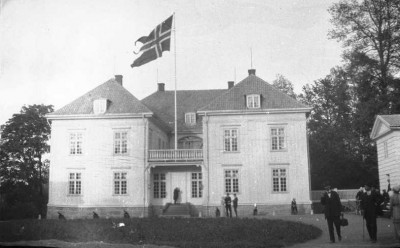Restoration work on the historic manor house in Eidsvoll where Norway’s constitution was developed and signed in 1814 has come to a halt, following unexpected archaeological discoveries in the building’s cellar. The discoveries are said to be of great cultural and historic value.

The stately old home known as Eidsvollsbygningen has been undergoing restoration in advance of Norway’s bicentennial celebrations in 2014. The government has allocated NOK 361 million for the project that aims to return the building and its grounds to the way they appeared when the modern Norway’s founding fathers met there to hash out the constitution (grunnloven) that was signed on the 17th of May, 1814.
The biggest single job has been to restore the 600-square-meter cellar of the home that had been built in 1770 by businessman and politician Carsten Anker. It was in the building’s cellar where servants lived and prepared meals for the 112 “Eidsvoll’s men” meeting upstairs.
And it was there, just last month, that workers made a surprise discovery while digging out the cellar’s floor. First they found a well under the house, then a beautifully laid brick floor buried under layers of flooring that had been applied later.
Insight into servants’ life
The brick and tile floor has been dated back to 1770, when the house was built following a fire in an earlier house on the site. Digging continued last month under the supervision of state conservationists and archaeologists and they found yet another floor made of natural stone about a meter below the tile and brick floor. It’s believed to date back to 1686, when another house stood at the site.
In addition to the unique flooring, workers also found stone benches and shelves they believe were used for storing wine and food.
“We could hardly believe it,” Erik Jondell, director of the organization in charge of the building, Eidsvoll 1814, told newspaper Aftenposten. “Until now, this cellar was used for storage, and then this ‘inner filet’ pops up. These discoveries offer a good picture of how life was for those working in the house during constitutional deliberations. Servants ran over these floors, in and out, with food and drink for the Eidsvoll men.”
Long and rich history
The house has a rich history, built as part of the industrial firm Eidsvoll Verk and used 44 years later as the birthplace of the Norwegian constitution. It was inspired by French and Danish architecture but was later modernized. In 1823, both the house, its furnishings and adjacent buildings and Eidsvoll Verk itself were sold at auction. The state took over the property in 1851.
It’s undergone major restoration and remodeling twice since, in 1914 and 1964. Only now, with the help of new technology, are archaeologists and experts from state conservation agency Riksantikvaren confident that they can restore the building to its original form.
The cellar and its historic flooring will be preserved and put on display in connection with bicentennial festivities in two years. Even though work stopped up last month when the discoveries were made, officials say it won’t delay the project.
“We have a deadline, and it’s the 17th of May, 2014,” Lasse Kwetzinsky of state building agency Statsbygg told Aftenposten. “We’ll be ready.”
Views and News from Norway/Nina Berglund
Please support our stories by clicking on the “Donate” button now:

